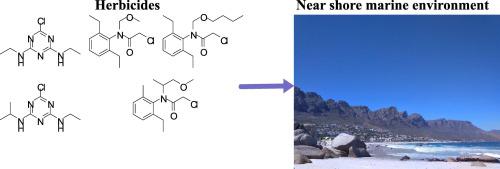Science of the Total Environment ( IF 8.2 ) Pub Date : 2021-02-25 , DOI: 10.1016/j.scitotenv.2021.146057 Cecilia Y. Ojemaye , Chionyedua T. Onwordi , Daniela M. Pampanin , Magne O. Sydnes , Leslie Petrik

|
During 2017 the herbicides alachlor, atrazine, butachlor, metolachlor, and simazine were detected in water samples, beach sediments and marine biota collected at Camps Bay, Cape Town, South Africa. During that period, the annual rain catchment record was 77,000 m3, whereas the volume of chemically laden sewage discharged via the marine outfall was 693,500 m3 making the marine sewage outfall by far the most predominant source for these herbicides in the bay. The chemical load in the discharged sewage was not removed by the applied pre-treatment step, which only uses a 3 mm screen to eliminate plastic, paper, rags and other foreign materials. After passing through the Camps Bay pump station, the sewage is released to the bay at the following GPS position 33°56′42.214″ S 18°21′59.257″ E (Colenbrander et al., 2021) and at a discharge depth of 23 m and 1497 m from the beach. In our study the presence in marine biota of atrazine and simazine were taken as being indicative of the chemical signature of the sewage being released through the outfall, since these compounds were detected previously in the sewage prior to discharge. To our knowledge, our studies of the herbicides in diverse benthic organisms found in the near shore environment of Camps Bay are the first of their kind for this Western Cape region.
中文翻译:

坎普斯湾(南非开普敦)除草剂,补充
2017年期间,在南非开普敦坎普斯湾收集的水样,海滩沉积物和海洋生物区系中检出了除草剂甲草胺,阿特拉津,丁草胺,甲草胺和西马津。在此期间,年度雨水收集量记录为77,000 m 3,而通过海洋排污口排放的化学负载污水量为693,500 m 3。使海洋排污口成为海湾中这些除草剂的最主要来源。所应用的预处理步骤并未消除排放的污水中的化学负荷,该步骤仅使用3毫米的筛网来清除塑料,纸张,碎布和其他异物。通过坎普斯湾泵站后,污水在以下GPS位置33°56′42.214″ S 18°21′59.257″ E(Colenbrander et al。,2021)处以23的排放深度释放到海湾米,距离海滩1497 m。在我们的研究中,阿特拉津和西马津在海洋生物中的存在被认为是通过排污口释放的污水的化学特征的指示,因为这些化合物是在排放之前在污水中被检测到的。据我们所知,











































 京公网安备 11010802027423号
京公网安备 11010802027423号